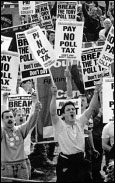The twenty-seventh amendment states...
No law, varying the compensation for the services of the Senators and Representatives, shall take effect, until an election of Representatives shall have intervened.
What it means to me...
This amendment prohibits Congress from raising their salaries during their terms of service. Members of Congress cannot receive a salary increase until after the next election. It was originally proposed as part of the original Bill of Rights, but it failed to be ratified at that time. It was later re-introduced in the early 1980's and was finally ratified in 1992.
The following is a cartoon depicting Congressional greed...

This political cartoon suggests that Congress is greedy and that their solution for our crumbling economy is to give themselves raises, to an extent.
The following is a second political cartoon about congress being greedy while we are suffering...

This political cartoon is suggesting that Congressman are greedy and are more likely to give themselves a pay raise at our expense. Everyone else is making sacrifices, but Congressman do not have the same mindset.




